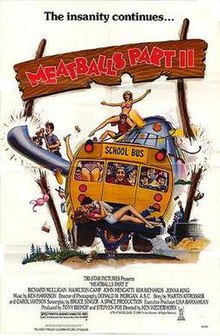Meatballs Part II is a 1984 American comedy film and the first sequel to the 1979 film Meatballs. The film stars Richard Mulligan, Hamilton Camp, John Mengatti, Kim Richards, Archie Hahn, Misty Rowe, and John Larroquette, and was directed by Ken Wiederhorn.[1][2] The screenplay for the film was written by Bruce Franklin Singer based on a story by Martin Kitrosser and Carol Watson.[3]
| Meatballs Part II | |
|---|---|
 Theatrical release poster | |
| Directed by | Ken Wiederhorn |
| Written by | Bruce Franklin Singer (credited as Bruce Singer) |
| Story by |
|
| Produced by |
|
| Starring | |
| Cinematography | Donald M. Morgan |
| Edited by | George Berndt |
| Music by | Ken Harrison |
| Distributed by | Tri-Star Pictures |
Release date |
|
Running time | 87 minutes |
| Country | United States |
| Language | English |
| Box office | $5,410,972 |
Plot
editThe owner of Camp Sasquatch, Giddy, tries to keep his camp open after Hershy, the owner of Camp Patton, located just across the lake, wants to buy the entire lake for Camp Patton. Giddy suggests settling the issue with the traditional end-of-the-summer boxing match over rights to the lake. A tough, inner city punk named Flash is at Camp Sasquatch for community service as a counselor-in-training. Flash is recruited to box in order to save Sasquatch. Cheryl, a naive teen on whom Flash has set his sights, has never seen a "pinky", so her fellow teenage girl campers arrange for her to see a man naked. Meanwhile, the campers try to hide an alien from another planet who has been dropped off by his parents to learn Earth culture. He is nicknamed "Meathead" by the kids after repeating one of them saying "Me, Ted".
Cast
edit- Richard Mulligan as Coach Giddy
- Hamilton Camp as Colonel Jack 'Batjack' Hershy
- John Mengatti as Armand 'Flash' Carducci
- Kim Richards as Cheryl
- Archie Hahn as Jamie / Voice of Meathead
- Misty Rowe as Fanny
- John Larroquette as Lieutenant Felix Foxglove
- Paul Reubens as Albert
- Joe Nipote as 'Boomer'
- Jason Hervey as Tommy
- Ralph Seymour as Eddie
- Elayne Boosler as Mother
- Nancy Glass as Daughter
- Felix Silla as 'Meathead'
- Joaquin Martinez as Chief Rawhide
- Blackie Dammett as Sergeant Paladin
- Donald Gibb as 'Mad Dog'
- Jason Luque as Jai Styxxx
Reception
editMeatballs Part II grossed $2,515,268 the first week-end.[4] The film grossed $5,410,972 domestically overall.[5]
Critical response
editCritic Lawrence Van Gelder of The New York Times wrote in his review: "Trailing bits of Rocky and E.T. and using a plot device from the 1983 film Screwballs, which itself aspired to be Porky's, Meatballs Part II shares with 1979's Meatballs not much more than a summer camp setting. This time - amid the efforts of two senior counselors to find sexual privacy, amid prurience and budding romance involving an innocent blonde preppy and a young punk given a choice of a counselor's job or reform school, and amid the efforts of some of the little campers to harbor an extraterrestrial - the future of Camp Sasquatch is in peril.[6]
Rotten Tomatoes lists only two critics' reviews, both of which are negative. Lawrence Van Gelder of the New York Times said, "Pallid writing, awkward acting, familiar situations and tired jokes make the morons, wimps and losers of Meatballs Part II easy to pass up." TV Guide reported, "The difference between this movie and the original is Bill Murray, whose charm gave the first film its best moments and raised the mediocre plot into something mindless but sweet." Meanwhile, 675 users have scored the movie with an average of 2.5 out of 5; only 23% of those users reported liking "Meatballs Part II."[7]
Release
editMeatballs Part II was released in theaters on July 27, 1984. The film was released on DVD on March 4, 2011, by Sony Pictures Home Entertainment.[8]
References
edit- ^ "Meatballs Part II". Turner Classic Movies. Atlanta: Turner Broadcasting System (Time Warner). Retrieved January 31, 2017.
- ^ "Meatballs Part II". MUBI. United Kingdom. Retrieved January 31, 2017.
- ^ Pittsburgh Press Staff 1984, p. 26.
- ^ "Meatballs Part II". Box Office Mojo. United States: Amazon.com. Retrieved January 31, 2017.
- ^ "Meatballs Part II". Box Office Mojo. United States: Amazon.com. Retrieved January 31, 2017.
- ^ Van Gelder, Lawrence (August 18, 1984). "Screen: 'Meatballs Part II,' Hih Jinks At Summer Camp". The New York Times. New York City. Retrieved January 31, 2017.
- ^ "Meatballs Part II". Rotten Tomatoes. Retrieved March 15, 2017.
- ^ "Meatballs Part II". Sony Pictures Home Entertainment. Culver City, California: Sony Pictures Entertainment. March 4, 2011. ASIN B004HGQMW8. Retrieved January 31, 2017.
Sources
edit- Pittsburgh Press Staff (July 27, 1984). "Meatballs Part II". Pittsburgh Press. Pittsburgh: E. W. Scripps Company (1924–1992)
Block Communications (2011–present). p. 26. Retrieved January 31, 2017.(subscription required)
External links
edit- MeatballsOnline Meatballs Movie Website
- Meatballs Part II at IMDb
- Meatballs Part II at the TCM Movie Database
- Meatballs Part II at Rotten Tomatoes